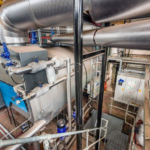A major energy overhaul at Oxford University Hospitals NHS Foundation Trust is on track to save £2m and 10,000 tonnes of CO2 in its first year.
Last November, The Energyst reported that a new energy centre and upgrades at Oxford University Hospitals NHS Foundation Trust (OUH) had saved almost a quarter of a million pounds in its first month.
The remarkable figures prompted us to invite Claire Hennessy, head of OUH operational estates and facilities management, to speak at The Energyst Event in April, alongside energy project manager, Mark Bristow.
The project delivered a 4.5MWe combined heat and power (CHP) plant, heat network and HV link between the John Radcliffe and Churchill hospitals, which are 2.2km apart. It also included new boilers, heat exchangers, chillers, a new building management system and some 6,400 light fittings.
All of which had to be undertaken without disrupting patient care.
Risk transfer

Hennessy and Bristow explained that the project was conceived back in 2012, but took several years to come to fruition. That was partly because the required investment was deemed too large to undertake as a capital project. Eventually a funded energy performance contract model was found that would guarantee savings – enabling the Trust to transfer the risk to the private sector.
Aviva provided the investment and Vital Energi delivered the package, with the total project costing £14.8m. The 25-year contract guarantees savings of £462k per annum. However, said Hennessy, “six months after the project went live, we have actually seen savings of £1.5m, far beyond what we originally dreamed of”.

Moreover, said Bristow, “where projected savings are exceeded, Vital Energi and the Trust share savings, which helps ensure the project continues to be efficient and deliver savings long into the future”.
Win-win
Last week OUH confirmed savings for the year to October are set to hit £2m. The upgrade is also on track to cut the Trust’s carbon footprint by 10,000 tonnes a year, reducing total C02 emissions by a third.
Crucially, said Hennessy, there are no more breakdowns from 40-year-old heating plant. “That has cut backlog maintenance by £11m over three years. It means my maintenance teams can focus on other areas that require attention.”
Meanwhile, an optimised building management system (BMS) is providing much more detailed consumption data. “That allows us to target key areas to undertake further energy efficiency work,” she added.


Off grid, on tap
The Churchill hospital is now “completely off grid and fed 24/7 by the CHP,” said Hennessy, with any extra power used to feed the John Radcliffe hospital. That has “significantly reduced” their combined £5.9m energy bill, she added.
The waste heat generated by the CHP is also used to heat the hospitals’ water, said Bristow. The heat network between the two sites means “any heat we do not need in the John Radcliffe goes to Churchill, so we are throwing away very little energy”.
The upshot of the upgrade is that the Trust now has the infrastructure to underpin healthcare services for the next 25 years – as well as significant energy bill savings.
Hennessy added that the new lighting also makes a positive difference to the environment for both staff and patients. “It’s a much brighter place to be,” she said, which succinctly sums up the whole project.
This article was written for The Energyst’s September print issue. The magazine is free to all of those with some responsibility for energy within their organisation. Click here to subscribe.
Related stories:
Heat and light upgrades save Oxford hospitals £7.5k a day
Vital Energi claims EPCs with 14 hospitals cuts energy bills by £300m
Click here to see if you qualify for a free subscription to the print magazine, or to renew.
Follow us at @EnergystMedia. For regular bulletins, sign up for the free newsletter.



